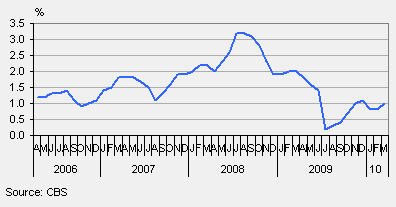Dutch inflation slightly up

In March, Dutch inflation was 1.0 percent, i.e. 0.2 percentage points up on February. Inflation is defined as the consumer price index (CPI) increase relative to the same month one year previously.
The increase is predominantly caused by petrol prices. The price of petrol was 17 percent higher than in March 2009. The increase was more substantial than in February, when petrol prices were 13 percent up on one year previously. Vegetable prices also contributed to the inflation increase.
With 0.7 percentage points, the transport sector accounted for most of March’s inflation. Recreation and culture together contributed 0.2 percentage points. Housing, water and energy (0.4 percentage points) and food and soft drinks (0.2 percentage points) had a downward effect on inflation. Other goods and services hardly contributed to inflation in March.
The harmonised consumer price index (HICP) allows comparison between the inflation rates in the various member states of the European Union (EU). According to the HICP, the Netherlands had an inflation rate of 0.7 percent in March. This is 0.4 percentage points up on February’s rate, but far below the average eurozone level. Eurostat, the European statistical office, calculated an inflation rate of 1.4 percent in the Eurozone in March.
Dutch inflation
